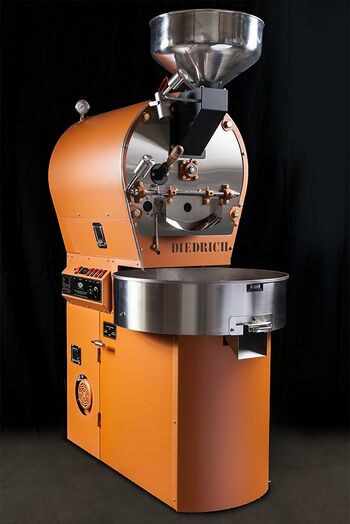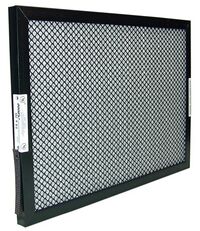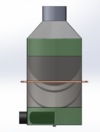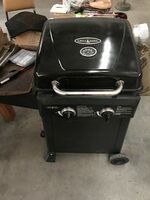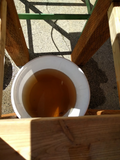Coffee Roaster Filtration System
| Copyright Diedrich Roasters | |
| Project Duration |
|
| Sponsors | |
| Team Name |
|
| Faculty Advisor |
|
| Mentor |
|
| Client |
|
| Team Members |
|
The goal of the project is design, fabricate, and test a low-cost air filtration system for an industrial batch coffee roaster. The system will reduce visible smoke output by 95% and mitigate odor transmission. The system is adaptable to Diedrich Roaster's IR-5 and IR-12 models, and serves as a more affordable alternative to their catalytic oxidizer.
Problem Definition[edit | edit source]
Background[edit | edit source]
Roaster Emissions
The unique chemical compositions of coffee beans result in diverse emissions during the roasting process. These emissions can be generalized into two categories: Gaseous emissions and particulate matter (PM).
In batch roasting, the primary gaseous release of concern is carbon dioxide, factoring for approximately 10% of gaseous emissions up to as high as 25% in roasters which utilize thermal oxidizers in post-treatment. A small amount of carbon monoxide is released as well, but at near-negligible rates.
Both carbon monoxide and carbon dioxide are relatively color- and odorless. The main cause of smell and smoke in roasting comes from various classes of volatile organic compounds (VOC). VOCs are any number of organic (containing carbon) compounds that have a relatively low boiling point, near room temperature (volatile). Methane is a common VOC, but the are myriad compounds which fall within the category. Due to coffee's complex chemical nature, identifying the specific VOC's emitted is a challenge, as each bean will release a slightly different combination.
Particulate matter (PM) refers to solid matter, typically waste carbon, ejected during oxidation. In coffee roasting, this primarily appears in the form of chaff.
Emissions Regulations
In commercial applications, local governments often have emissions codes dictating an upper limit on allowable emissions from coffee roasters. These emissions typically aim at mitigating greenhouse gases, which are primarily generated by the natural gas burners that serve as the main emissions source.
Most smaller companies and private roasters are not bounded by regulations due to smaller batch sizes. Many standards, while very possible to achieve, are expensive and prohibitive towards smaller companies or individuals early in their roasting career, and few solutions exist on the market that are both emissions-compliant and affordable. Rather than emissions reduction, filtration systems for smaller outfits tend to focus on reducing more noticeable effects, such as smell and smoke.
Thermal Oxidizer
Because roasting happens below the point of combustion, the exhaust from a roaster is largely unburned matter. This is evidenced in the amount of VOC's reached, as many of the compounds are flammable. Thermal oxidisers exploit this issue by providing an afterburn to the exhaust of a roaster. By raising the exhaust temperature significantly and exposing the outgoing material to open flame, a thermal oxidizer is able to convert many of the harmful VOCs into CO2 and H20, the products of complete combustion in hydrocarbons.
Thermal oxidisers are one of the most common aftertreatment systems in the coffee roasting industry due to their effectiveness, and used in many other commercial settings, such as air control in factories. A common enhancement in these systems is the catalytic oxidizer, wherein the exhaust stream is forced through a catalytic converter. This also helps to mitigate some of the emissions from the natural gas burners.
Deliverables[edit | edit source]
The filter must be able to accept flow rates typical of the IR-5 and IR-12 and maintain acceptable filtration levels. The filter must be self-supported and capable of existing as a standalone system. The design must be low-cost, constructed primarily of sheet metal, and low-maintenance. Finally, the system should be innovative, setting itself apart from other filtration systems on the market.
Specifications[edit | edit source]
| Flow Rate | 1500 cfm <cn> |
| Backpressure | -.15 - .25 inH20 |
| Dimensions | 4ftL x 4ftW x 6ftH |
| Maintenance Interval | > 8 hrs (1 workday)/service |
| Operational Lifespan | Indefinite |
| Smoke Reduction | 95% |
| Material Costs | $3300 |
| Operable Temperatures | Up to 500 °F |
Design Alternatives[edit | edit source]
Electrostatic Precipitator (ESP)[edit | edit source]
An electrostatic precipitator uses electric charge to attract pollutants as flow passes through. ESP's have low flow obstructions, which makes them ideal for many scenarios such as HVAC. They are also energy efficient, as they apply energy to particulate matter as opposed to the entire flow. However, their collection efficiency is determined by resistivity, an electrical property highly dependent on temperature. This means that ESP's are designed for specific temperature ranges, and higher temperatures result in both higher material and operating costs.
Electrostatic Filter[edit | edit source]
An electrostatic filter operates on the same principles as ESPs, but instead of having an external power source, generates static charge from particulate as it passes through. Electrostatic filters are common in household and smaller commercial use due to their ability to filter fine particulate. They are also have a low cost associated with them and an essentially infinite operational lifespan.
Nonetheless, electrostatic have a number of shortcomings. Of the filtration systems researched, they have the lowest operational efficiency, especially as particulate size increases. They also require consistent cleaning, and have a tendency to become a haven for mold in high-humidity environments, a dangerous habit for systems dealing with organic matter. Finally, they too suffer from efficiency losses with increases in temperature.
Wet Filter[edit | edit source]
Wet filters are another passive filter system, like the electrostatic filter. Unlike the electrostatic filter, though, wet filters do not rely on electrical principles. Instead they use a trapping fluid, typically water, that collects particulate matter from a flow passing through it. Wet filters are among the most efficient and versatile of passive filters, and, when properly utilized, can filter gaseous pollutants or particulate matter. They also enjoy the low costs common in passive filter design. However, they do not have the infinite lifespan of electrostatic filters and suffer from the inherently high-humidity environment.
Wet Scrubber[edit | edit source]
Wet scrubber refers to a whole class of filtration systems that use injection of a filtering fluid into the exhaust flow. Wet scrubbers can be optimized for gaseous pollutants and particulate matter of various sizes. They are becoming increasingly popular in industries that make use of boilers and furnaces due to their effectiveness against ashes and their ability to lower exhaust temperatures.
The wet scrubber we researched and ultimately decided to incorporate into our final design is a Venturi wet scrubber. Finer particulate trapping requires higher energy in the spray to decrease droplet size. A Venturi wet scrubber uses the Venturi effect, wherein flow is directed through a converging cone into a smaller diameter tube, increasing velocity. This passive design takes energy from the airflow, reducing the necessary energy input from the spray.
Wet scrubbers have a number of advantages over other filtration systems. They are the only researched active filter that can handle gaseous emissions, which are assumed to be the primary culprit of odor transmission. They are able to handle far higher temperatures than electrostatic systems without compromising trapping efficiency. Most importantly, because they significantly lower temperatures of the exhaust flow, they can reduce the amount of ducting necessary, decrease costs of fans and tubing that no longer requires high-temperature durability, and act as a suitable first-stage filter in a multistage design.
There are, however, known issues with wet scrubbers. The primary issue, which is partially rectified with a Venturi tube, is a high power requirement for fine particulate trapping. The issue of using the Venturi tube is an increased pressure drop, a consideration of high importance, as backpressure has a known pronounced effect on roasting quality. The secondary issue is of disposal of the waste: Trapped pollutants are often corrosive and require further treatment to meet wastewater regulations.
Design Solution[edit | edit source]
The proposed design solution is a cyclonic wet scrubber with electrostatic after-treatment, pictured left. The exhaust flow enters the filter through an angled pipe, generating swirl for larger particulate separation. A grid of 9 high-pressure injectors sprays down on the flow as it rises through the filter. This simultaneously cools the exhaust to more manageable temperatures and traps fine particulate. At the top of the filter, the flow passes through a porous sponge into a reducing cone before finally exiting.
A recirculation loop was implemented to produce an independent closed system. This loop consists of a 5-gallon reservoir, a high flow pump, a 1-micron water filter, and associated hosing. Water drained from the scrubber enters the reservoir, where it is pulled out by the pump through the water filter and out of the nozzles. The benefits of this system are improved pressure control, reduction of water use, and better filtering to the nozzles to reduce clogging.
Opacity Meter[edit | edit source]
An opacity meter is used to measure the level of visibility reduction in a flow stream and consists of a dark chamber, photo sensor, and LED emitter. The sensor and emitter are placed opposite each other inside the chamber. Light emitted from the LED is measured by the sensor and converted into a lux reading. As smoke levels increase in the exhaust flow, the emitted light is scattered, reducing signal. The signal is processed by an Arduino Uno with an output digital display. This allows for instantaneous display of value as well as time studies of data.
Smoke Generator[edit | edit source]
A modified barbecue grill allows for simulation of smoke output from the IR-12 roaster. The chamber is sealed with removable foil to limit oxygen intake and to force generated smoke through a singular exit leading to the filter. A thick meshed char pan holds smoking pellets and diffuses heat to the pellets evenly. At approximately 200 degrees Fahrenheit, the pellets begin to generate smoke, peaking at 350 degrees. A high-volume, high-temperature fan pulls the air from the chamber into the filter.
Results[edit | edit source]
Smoke generation was higher than expected with the current system. Water injection resulted in a decrease in flow temperature and noticeable odor; however, smoke was still visible. A large volume of water in the reservoir was lost during testing to steam escape. The team believes this steam was the cause of the visibility of the exhaust gas.
The opacity meter was affected both by the bright ambient light from testing on sunny days as well as the reflective nature of steam in the exhaust, resulting in unusable data. The system was able to filter pollutants from the exhaust stream, as demonstrated by the change in color of water in the reservoir over five minutes of operation. The result is a noticeable darkening of the water.
Based on these results, a vapor trap or condenser should allow for nearly complete reduction of exhaust stream visibility and pollution level. The team was able to successfully create a working proof-of-concept of the wet scrubber as a filtration technology in coffee roasters, and generate testing equipment for the validation and future development of this project.
Meet the Team[edit | edit source]
| Adam Niemet:
Major: Mechanical Engineering
| |
| Patrick Paulus:
Major: Mechanical Engineering
| |
| Samantha Peters:
Major: Biological Engineering
| |
| William Overstreet:
Major: Mechanical Engineering
|

